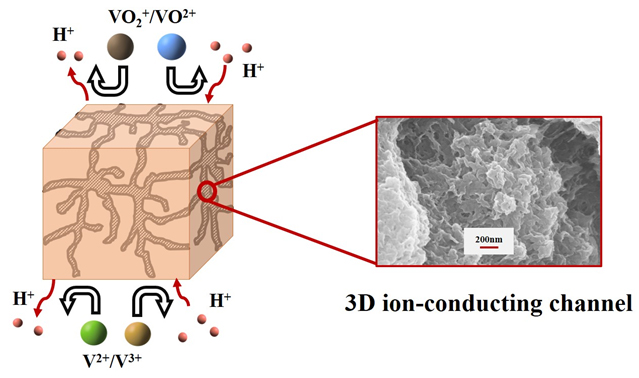| [1] |
Turner, J. A. Science 1999, 285, 687.
doi: 10.1126/science.285.5428.687
|
| [2] |
Qing, G. L.-T.; Guo, W.-N.; Liu, P.; Wang, B.-G. J. Electrochem. 2015, 21, 449. (in Chinese)
|
|
( 青格勒图, 郭伟男, 刘平, 王保国, 电化学, 2015, 21, 449.)
|
| [3] |
Kim, S.; Yan, J.; Schwenzer, B.; Zhang, J.; Li, L.; Liu, J.; Yang, Z.; Hickner, M. A. Electrochem. Commun. 2010, 12, 1650.
doi: 10.1016/j.elecom.2010.09.018
|
| [4] |
Zhao, Y.-T.; Xi, J.-Y.; Teng, X.-G.; Wu, Z.-H.; Qiu, X.-P. Acta Chim. Sinica 2011, 69, 132. (in Chinese)
|
|
( 赵永涛, 席靖宇, 腾祥国, 武增华, 邱新平, 化学学报, 2011, 69, 132.)
|
| [5] |
Li, L.; Kim, S.; Wang, W.; Vijayakumar, M.; Nie, Z.; Chen, B.; Zhang, J.; Xia, G.; Hu, J.; Graff, G. Adv. Energy Mater. 2011, 1, 394.
doi: 10.1002/aenm.v1.3
|
| [6] |
Ulaganathan, M.; Aravindan, V.; Yan, Q.; Madhavi, S.; Skyllas-Kazacos, M.; Lim, T. M. Adv. Energy Mater. 2016, 3, 1500309.
|
| [7] |
Wei, X.; Nie, Z.; Luo, Q.; Li, B.; Chen, B.; Simmons, K.; Sprenkle, V.; Wei, W. Adv. Energy Mater. 2014, 3, 1215.
doi: 10.1002/aenm.v3.9
|
| [8] |
Wan, Y. H.; Sun, J.; Jiang, H. R.; Fan, X. Z.; Zhao, T. S. J. Power Sources 2021, 489, 229502.
doi: 10.1016/j.jpowsour.2021.229502
|
| [9] |
Wang, F.-R.; Jiang, F.-J. Prog. Chem. 2021, 33, 462. (in Chinese)
|
|
( 王斐然, 蒋峰景, 化学进展, 2021, 33, 462.)
doi: 10.7536/PC200567
|
| [10] |
Zhou, X.; Xue, R.; Zhong, Y.; Zhang, Y.; Jiang, F. J. Membrane Sci. 2020, 595, 117614.
doi: 10.1016/j.memsci.2019.117614
|
| [11] |
Zhang, B.-G.; Zhang, S.-H.; Xing, D.-B.; Yin, C.-X.; Han, R.-L.; Jian, X.-G. Acta Chim. Sinica 2011, 69, 2583. (in Chinese)
|
|
( 张本贵, 张守海, 邢东博, 尹春香, 韩润林, 蹇锡高, 化学学报, 2011, 69, 2583.)
doi: 10.6023/A1103152Q
|
| [12] |
Li, L.-Q.; Chen, J.-W.; Lu, H.; Jiang, C.-P.; Gao, S.; Yang, X.; Lian, X.-J.; Liu, X.-J.; Wang, R.-L. Acta Chim. Sinica 2009, 67, 2785. (in Chinese)
|
|
( 李良琼, 陈金伟, 鲁惠, 姜春萍, 高山, 杨鑫, 练晓娟, 刘效疆, 王瑞林, 化学学报, 2009, 67, 2785.)
|
| [13] |
Ling, L. A.; Min, X. A.; Dh, B.; Shan, R. A.; Sw, A.; Ym, A. J. Membrane Sci. 2019, 585, 230.
doi: 10.1016/j.memsci.2018.11.082
|
| [14] |
Fu, L.; Hashim, N. A.; Liu, Y.; Abed, M.; Li, K. Fuel Energ. Abstr. 2011, 375, 1.
|
| [15] |
Li, B.-Y.; Liu, Z.-H.; Wang, B.-G. CIESC J. 2017, 68, 732. (in Chinese)
|
|
( 李冰洋, 刘珍豪, 王保国, 化工学报, 2017, 68, 732.)
|
| [16] |
Yang, X.; Zhu, H.; Jiang, F.; Zhou, X. J. Power Sources 2020, 473, 228586.
doi: 10.1016/j.jpowsour.2020.228586
|
| [17] |
Lai, Y.; Wan, L.; Wang, B. Membranes 2019, 9, 89.
doi: 10.3390/membranes9070089
|
| [18] |
Mai, Z.; Zhang, H.; Li, X.; Xiao, S.; Zhang, H. J. Power Sources 2011, 196, 5737.
doi: 10.1016/j.jpowsour.2011.02.048
|
| [19] |
Ling, L.; Xiao, M.; Han, D.; Ren, S.; Meng, Y. J. Membrane Sci. 2019, 585, 230.
doi: 10.1016/j.memsci.2018.11.082
|
| [20] |
Luo, X.; Lu, Z.; Xi, J.; Wu, Z.; Zhu, W.; Chen, L.; Qiu, X. J. Phys. Chem. B 2005, 109, 20310.
doi: 10.1021/jp054092w
|
| [21] |
Li, B.; Wang, B.; Liu, Z.; Qing, G. J. Membrane Sci. 2016, 111.
|
| [22] |
Xue, R.; Jiang, F.; Wang, F.; Zhou, X. J. Power Sources 2019, 449, 227475.
doi: 10.1016/j.jpowsour.2019.227475
|
| [23] |
Sun, C.; Jian, C.; Zhang, H.; Xi, H.; Luo, Q. J. Power Sources 2010, 195, 890.
doi: 10.1016/j.jpowsour.2009.08.041
|
| [24] |
Jiang, B.; Wu, L.; Yu, L.; Qiu, X.; Xi, J. J. Membrane Sci. 2016, 510, 18.
doi: 10.1016/j.memsci.2016.03.007
|
| [25] |
Zhang, Y.; Zhou, X.; Xue, R.; Yu, Q.; Jiang, F.; Zhong, Y. Int. J. Hydrogen Energ. 2019, 44, 5997.
doi: 10.1016/j.ijhydene.2019.01.043
|
| [26] |
Zhao, Y.; Zhang, H.; Xiao, C.; Lin, Q.; Li, X. Nano Energy 2018, 48, 353.
doi: 10.1016/j.nanoen.2018.03.070
|
